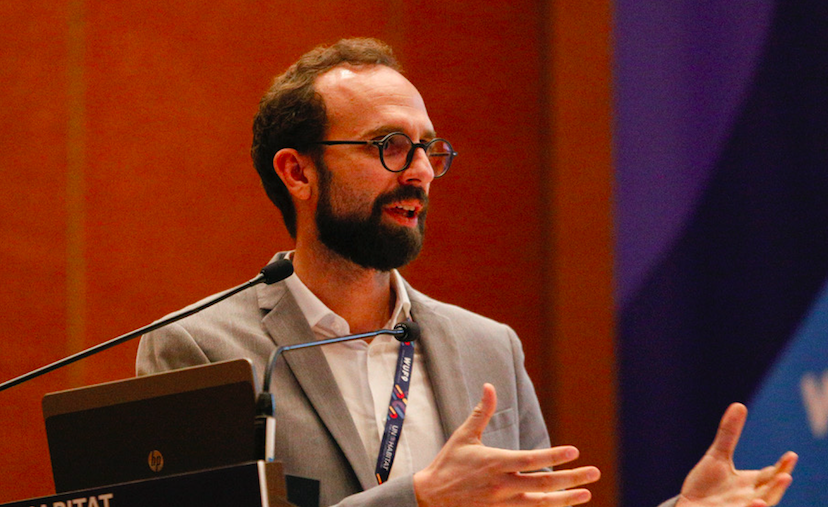
Photo: Screen-Shot-2018-02-22-at-12.56.37
Milan’s first Chief Resilience Officer takes the helm
22 February 2018
by Jonathan Andrews
Piero Pelizzaro was named as Milan’s Chief Resilience Officer (CRO) in December. Barbara Szewcow spoke to him about the challenges that lay before him as he draws up the city’s first resilience strategy
What are the main challenges facing Milan?
In recent years, Milan has undergone exceptional growth and change in its urban landscape and economy. The newest additions to the city’s skyline, Porta Nuova and CityLife, have increased the city’s GDP value as a start-up digital economy, turning the world’s fashion and design capital into a financial and smart community.
However, as with every revolution, there are negative impacts. This change in landscape and housing created an important challenge for the community in terms of social inequality. To tackle this, municipalities have invested in social inclusion policies as well as launching a €300-million Peripheries Plan. Meanwhile, a new manufacturing policy has been created, in order to address the risk of losing our manufacturing tradition and identity. This includes almost €20 million in financial support to improve knowledge sharing among young entrepreneurs, unemployed people, universities and city administrators. Urban sprawl, which occurred right up until the early 1990s, has left an industrial wasteland within the city perimeter. A potential investment of almost €500 million into the regeneration of five railway lines will lead to a future green belt around the city.
These are local challenges, but the city has also taken steps to welcome thousands of people who have now become an important cultural and labour resource, through its Social & Emergencies Department. The department’s board includes important organisations such as the excellent 100 Resilience Cities Network—which joined in 2015—as well as C40 and EUROCITIES, making Milan a key actor in climate change.
Further announcements are coming including a new urban forest strategy integrated with local food policy and our €20-million financial support for the replacement of the city’s remaining 3,500 old heating systems. There are also high expectations of my future resilience strategy, that will include new adaptation policies for the city.
Which cities do you look to for inspiration?
I recently attended the 9th World Urban Forum in Kuala Lumpur, where I had the opportunity to hear about Melbourne’s Urban Forest Plan which aims to mitigate the impact of heat waves, as well as Manchester’s metropolitan approach to urban resilience.
Because none of the three rivers that run through Milan start or end inside the urban area, it will be essential to work with the surrounding metropolitan governments.
Other key policies include the City of New York’s mandatory high-energy efficiency standards for buildings larger than 25,000 square metres. Moreover, collaboration between Athens and Amman on mainstream refugee resilience policies and actions, with the support of the International Rescue Committee, could serve as an example as we work to promote future inclusion policies. In addition, we are looking at Rotterdam’s management system. We suffer large water stresses due to flooding, and Rotterdam’s Water Square idea could fit perfectly with the Reinventing Cities call for projects that we have just launched, and could become part of the new set of rules for our Territorial Zoning Plan (Piano di Governo del Territorio).
My colleague and inspiring CRO from Paris, Sebastien Marie, also gave a great example of how social climate resilience could be improved through putting community gardens and farms in schools, which improve the greening and livability of educational centres, as well as reduce food costs. This system will also be part of our strategy, due to the large number of requests we have received from the 100 Resilient Cities Network to work together on this–from Barcelona, Jakarta, Semarang, Da Nang, Chennai, and Quito. Many more are likely to soon join the Milan Food PACT which already involves 163 cities.
How are you planning to maximise the financial support you receive from the Rockefeller Foundation?
The funding Milan receives from the 100 Resilient Cities–a separate legal entity to the Rockefeller Foundation–is split. Twenty-five percent is set for the salary of the CRO and part of the team, and here I want to highlight how the Mayor, Beppe Sala, and City Manager, Arabella Caporello, have taken the important decision to co-fund the department so that four people who currently work in another unit will join the City Resilience Department. Another 25 percent is used to identify technical support selected by 100RC. In our case, this is the ARUP London Officem through their team in Milan. Finally, 50 percent is allocated to the process to identify a partner of the 100RC platform in the second phase of the programme–the Preliminary Resilience Assessment, set for June. These partners include private companies such as Arcadis but also NGOs like the International Rescue Committee. This decision will be based on the scientific knowledge and the participatory process that we will launch in April.
Have you defined the core steps that will guide you in the creation of Milan’s resilience strategy?
I am building a working team and aligning resources and expectations to support the CRO and the strategic development process. This is a challenge not only for us but also for the future of Urban Resilience Policies in Italy. We are the first municipality in the country to introduce a proper and legally designed City Resilience Department, so I am now close to having part of the team and discussing it with my Deputy Mayor, Pierfrancesco Maran and City Manager Arabella Caporello, who are from our Competencies Department. It is a great experience which enables me to gain oversight of all the different plans and actions of the city.
I have also begun to conduct appropriate and inclusive outreach to understand the full landscape of stakeholders who are affected by and committed to resilience building. Simultaneously, we are in the phase of engaging city leaders to formalise governance and support through a Resilience Steering Committee, and I am placing myself as CRO on the Scientific Advisory Board to ensure commitment and quality during and after the strategy development process.
From here and through research, stakeholder engagement, new analytical tools, and an evaluation of existing actions and plans, I will develop and validate a Preliminary Resilience Assessment (PRA) for the city. Hopefully in May or early June, there will also be an international review of it from different 100 Resilient Cities teams. This includes great support from the London, New York and Singapore offices.
Building on the analysis of the PRA, Milan will identify key topics for resilience building which require further research. These are known as Discovery Areas and will be my main focus from now until June. For the next steps, we have a set plan but I’d like to focus on the step-by-step activities because we have the Territorial Zoning Plan, Urban Forest Policy, Climate Action Plan and the Heating-Pump Funding scheme to work on before the summer holidays.
What will be your main responsibilities as CRO?
First, making resilience possible and understandable for every citizen, from students to grandmothers. This will be a real challenge once resilience becomes the next trend, or even worse, meets with resistance from some ‘innovators’ because it calls for a different approach to business and policy-making. Resilience could break the status quo, because of all the shock and stress required to tackle it. Challenges such as water, refugees, and climate crises cannot be addressed by traditional practices.
I will also be responsible for leading the city and stakeholders through the process of assessing the city’s holistic resilience, identifying and developing resilience initiatives to prioritise and coordinate its implementation. To ensure an inclusive strategy development process, each city has a core team working closely with me to support them in the development, design and execution of the Resilience Strategy.
Finally, I hope to support our mayor and deputies as much as possible in reaching the international climate change commitment that we have signed: to create a fossil-fuel-free zone by 2025 in order to improve air quality; to increase walkability and the use of the bikes in our communities; and to reduce CO2 emissions by 40 percent (according to the Global Compact of Mayors) by 2030. All of this leads to the goal of becoming carbon neutral in 2050 as requested by C40. It appears a difficult and complicated task, but from these challenges emerge city and community resilience; we love to be challenged and to win.
What past experience are you bringing to your new position?
I was a young entrepreneur at Climalia, a climate-resilience start-up which gave me a chance to manage the complexity of the subject, and a researcher at the IUAV (Architecture University of Venice) Planning Climate Change Lab with one of the most qualified experts at the global level on urban resilience, Professor Francesco Musco. I worked with Musco on how to implement resilience in a mainstream way using existing urban planning regulations and strategic planning within the allocated budget. As a consultant, I had the pleasure of supporting the Bologna Municipality in designing the first ever resilience strategy in Italy with the BLUE AP programme. Working with very skilled practitioners, I became inspired to intervene effectively in public administration, and to ensure the resilience and energy of this field of knowledge have an impact. In addition, with BLUE AP and then Sharing Cities Lighthouse programme at the Milan Muncipality, I learned how the synergic political and technical components are compliant with Italian bureaucracy.
I have a strong international background and network thanks to my international colleagues, all of whom have helped me understand how every single city needs to be approached based on its behaviour and specific climatic and economic conditions. Being the youngest among all of them, with their trust, they have helped me believe in my capabilities. Finally, I would like to thank the previous vice-mayor, Ada Lucia De Cesaris, who believed in the 100 Resilient Cities programme, and to thank all my colleagues at the Milan Municipality for everything that I don’t know yet but I will surely learn from them in the years to come. Be good. Be resilient!






